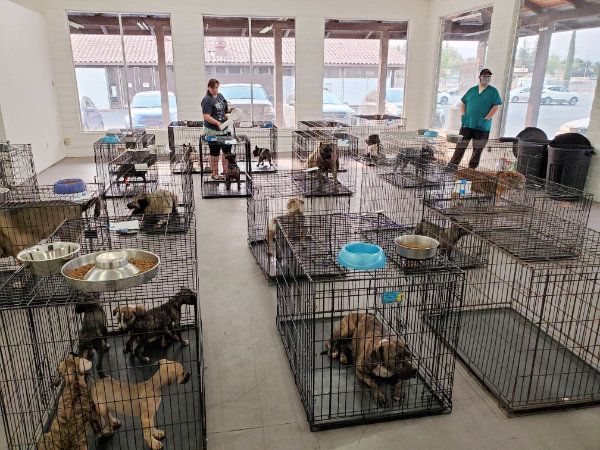
Hey, it’s September! Long-time readers know what that means! It’s time for Nancy’s annual reminder to PLEASE habituate your dog (and cats, and other pets!) to being in a crate! Why is September that time? How about for these reasons?
International Fund for Animal Welfare deploys to Louisiana to help rescue animals from Hurricane Ida
Caldor Fire prompts hundreds of animal rescues in California
Sacramento SPCA takes in puppies, other dogs, to ease crowding at Dixie Fire-area pet shelter
September just seems like the time when the crises pile one on top of the other – the natural disasters stack up. And any natural disaster that affects people, affects people’s pets.
Hurricanes and flooding, wildfire, earthquakes, tornadoes – there really isn’t anywhere in the United States that’s completely safe. Anyone could be fine one day and forced to evacuate their hometown the next. And when people need to evacuate or take shelter somewhere away from home, the safest place for their pets is safely confined in a crate.
So that brings me to my first recommendation: Have enough solid crates in an appropriate size for your dogs and other pets, in good working order, ready and available to you at the drop of a hat. NOT “Oh, I think there is one in the garage” (or barn rafters, or behind the shed). Not the one you brought the puppy home in and she barely fits in there anymore. I am talking about crates that are ready and tested, clean and not missing the parts they need to hold them together. (Although, if you are missing screws or bolts, heavy-duty plastic zip-ties work great for putting crates together fast in an emergency.)
Also, if you have three cats, including one who hates the other two, and two big dogs, you need at least four crates – and will they all fit in your car? With the humans who also need to evacuate if necessary?
Now, you may say, “If it’s a true run-for-your-life emergency, I will just stuff them in any dusty old crate and they will have to cope.” Okay, say you manage well enough in this configuration until you get to safety: Now what? Where will you stay while you are waiting days for the water to subside – or weeks while the wildfires keep your area off-limits to all but emergency personnel? Are you staying with friends or relatives? Will your pets be fine cohabitating with your hosts’ pets? Will you be staying at a hotel? Some may turn you away if you arrive with uncontained cats. If your pets are quiet and calm, and securely contained in crates that are large enough for their comfort, you will be a step ahead in finding a place to stay with them.
If your best plan is staying at a shelter, you may or may not be able to have your pets with you. Emergency shelters for natural-disaster victims vary. The best (in my opinion) will actually provide crates, litter boxes and litter, dishes and dog and cat food, and allow you to keep your pets with you, next to your Red Cross cot.
But in many emergency shelters, pets are not allowed – and if you have no place for them to stay, your dogs and cats will have to stay at an emergency animal shelter, where they will undoubtedly be living in crates. Volunteers will get them out at least twice a day to go potty, three or more times if your area’s disaster has been highly localized, as with a tornado or in an area where only one wildfire is burning. But if you live in one of the fire-stricken areas in northern California right now, you may discover that volunteers are stretched thin – there are multiple large fires that have evacuated millions of acres of land – and so the care for the animals may be minimal at best: your pets will be kept safe and fed, but dogs may have to endure cramped conditions and full bladders, or quite messy conditions in their crates, for longer than you can imagine.
I know: Nobody wants to imagine this. But a disaster is a disaster, and nothing is perfect in a disaster. The only thing that can make a disaster less disastrous is preparation: Having your family, human and nonhuman alike, ready for an evacuation at a moment’s notice. You can get started today – at least in compiling the things that you would need to stay away from your home with your pets for a few weeks, things like crates, food bowls, tethers and extra leashes and harnesses, pee-pads, any medicines they need, and so on. But to truly make them comfortable and secure, you need to practice putting them in the crates and teaching them to be happy in them.
If your dog is seriously crate-phobic, and you live in a disaster prone area (say, Louisiana during hurricane season or the western states during wildfire season), and a hurricane or fire is headed your way, get on the phone now to ask your veterinarian if you could get a prescription for medication that would help keep your dog calm if you had to evacuate. (Note: The October issue has an article that will help you retrain a crate-hating dog.)






Excellent article. And if some think they may not need this because they are not in storm or fire country. Several years ago, a nearby town experienced a train derailment. The train was carrying hazardous materials and residents were evacuated for many days.
Article is excellent. As much as I hated the crate training, my Toy Australian Shepherd got into to much mischief if she wasn’t in the crate in my absence. Now she even goes in on her own to lay down and relax. Crate training is really a kind thing to do for our pets.
Can’t emphasize what great advice this article is! We had to evacuate in the 2017 Northern California Tubbs Wildfire (ended up losing our house) and I don’t know what I would’ve done if my doggy and kitty hadn’t been crate trained. (Lucked out that my miniature poodle/bichon mix rescue came already crate trained!) We ended up staying with a friend – and her unfriendly-to-other-dogs dog and two cats – for 2 weeks, and then moved to two rentals before finally landing in a new-to-us home. All the while, having the option of crating my animals (used as sparingly as possible) made a very stressful, chaotic time more manageable. In subsequent evacuations (yes, living in what is now wildfire country is a challenge), again, crating helped in hotel rooms and at friends’. Note: My dog really likes his crate and seeks it out on his own.
Excellent article. I’ve always had a crate for each dog (they eat in their crates and occasionally spend time in them) plus crates in my car. You never know when you may need them. Although I hate being referred to as a Pet Guardian (I am a dog OWNER) the article was very good, and certainly timely.
I have spent 10 years working in veterinary clinics and hospitals, and listened to many stressed dogs upset at being confined. Already a stressful experience, those that were comfortable in a kennel rested much more than those poor frantic pups!
Those who insist that try their dogs won’t be “put in a cage “ are not doing their dogs any favors. Please crate train your dog!
Exactly. The stress of being taken from their homes and plunked into a cage in a room full of other stressed dogs is bad enough; to have to *learn* to be confined at that time is really awful. It’s clear to all the volunteers in shelters which dogs are already crate-trained; they do soooo much better.
Excellent article. Please remind everyone to use crates large enough for the dog or cat to stand up freely and to lie down with legs fully out-stretched.
Excellent article and one that I totally endorse. My dogs are crate trained from the time they come home in the first place. NOTE – putting a sheet over the crate also helps the dog relax. I have a strongly reactive dog who can tolerate the close presence of other dogs if he cannot see them. Yes, of course he can smell and hear them but cutting off that important visual cue has helped him a great deal. I use sheets over all my dog crates, it simulates “nap time,” and helps everybody settle down quickly.